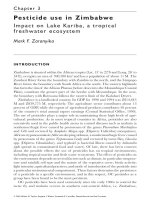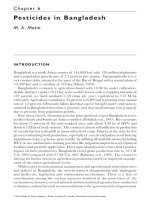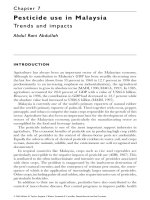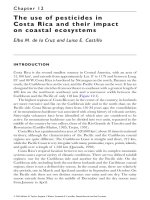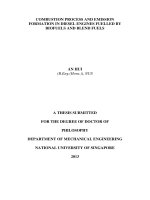Excellence in business communication 12e by vthill and brovee chapter 06
Bạn đang xem bản rút gọn của tài liệu. Xem và tải ngay bản đầy đủ của tài liệu tại đây (1.09 MB, 36 trang )
Copyright © 2017 Pearson Education, Inc.
Excellence in
in
Excellence
Business Communication
Communication
Business
Chapter 6
Completing Business Messages
Copyright © 2017 Pearson Education, Inc.
Learning Objectives
1.
(1 of 2)
Discuss the value of careful revision, and describe the tasks
involved in evaluating your first drafts and the work of other
writers.
2.
List four techniques you can use to improve the readability of
your messages.
3.
Describe eight steps you can take to improve the clarity of your
writing, and give four tips on making your writing more concise.
Copyright © 2017 Pearson Education, Inc.
Chapter 6 - 3
Learning Objectives
4.
(2 of 2)
List four principles of effective design, and explain the role of
major design elements in document readability.
5.
Explain the importance of proofreading, and give eight tips for
successful proofreading.
6.
Discuss the most important issues to consider when distributing
your messages.
Copyright © 2017 Pearson Education, Inc.
Chapter 6 - 4
Revising Your
Your Message:
Message:
Revising
Evaluating the
the First
First Draft
Draft
Evaluating
(LO 1) Discuss the value of careful revision, and describe the tasks
involved in evaluating your first drafts and the work of other
writers.
Copyright © 2017 Pearson Education, Inc.
Chapter 6 - 5
Revising Different
Types of Messages
•Revising Informal Messages
•Revising Digital Messages
•Revising Important Messages
Copyright © 2017 Pearson Education, Inc.
Chapter 6 - 6
Evaluating Your Message
Content
Clear and Accurate
Relevant and Complete
Organization
Order and Emphasis
Repetition and Grouping
Tone
Is It Too Formal?
Copyright © 2017 Pearson Education, Inc.
Is It Too Casual?
Chapter 6 - 7
Improving Your Message Through
Revision
Copyright © 2017 Pearson Education, Inc.
(1 of 2)
Chapter 6 - 8
Improving Your Message Through
Revision
Copyright © 2017 Pearson Education, Inc.
(2 of 2)
Chapter 6 - 9
Evaluating, Editing, and Revising the Work
of Other Writers
Promote the Writer’s Success
•
•
Help the writer succeed.
Don’t impose your own style or agenda.
Support the Writer’s Intent
•
•
Learn what the writer wanted to accomplish.
Base suggestions on the writer’s goals.
Copyright © 2017 Pearson Education, Inc.
Chapter 6 - 10
Questions for Evaluating Someone
Else’s Writing
•
•
•
•
•
•
•
What is the purpose of the message?
Who is the audience? What do they need?
Is the document well organized?
Does the writing convey a “you” attitude?
Is the writing clear? Can it be improved?
Is the writing as concise as it should be?
Does the design support the message?
Copyright © 2017 Pearson Education, Inc.
Chapter 6 - 11
Revising to
to Improve
Improve Readability
Readability
Revising
(LO 2) List four techniques you can use to improve the readability
of your messages.
Copyright © 2017 Pearson Education, Inc.
Chapter 6 - 12
Varying Your Sentence Length
• Up to 15
Words
Medium
• 15 – 25
• Over 25
Words
Words
Short
Copyright © 2017 Pearson Education, Inc.
Long
Chapter 6 - 13
Keeping Paragraphs Short
Average 100
Words
Maintain Clear
Flow
Copyright © 2017 Pearson Education, Inc.
•
•
•
•
•
•
Make Reading Easier
Promote Careful Reading
Emphasize Key Ideas
Don’t Go Overboard
Connect Your Ideas
Guide With Transitions
Chapter 6 - 14
Using Lists and Bullets to Clarify and
Emphasize
(1 of 2)
•
Sequence Ideas
•
Heighten Visual Impact
Set Off Ideas
•
Surface Key Points
in a List
•
Simplify Complex Subjects
•
Highlight Main Points
•
Enable Skimming
Copyright © 2017 Pearson Education, Inc.
Chapter 6 - 15
Using Lists and Bullets to Clarify and
Emphasize
Copyright © 2017 Pearson Education, Inc.
(2 of 2)
Chapter 6 - 16
Creating Parallelism
Copyright © 2017 Pearson Education, Inc.
Chapter 6 - 17
Adding Headings
and Subheadings
Primary Functions
Functions
Primary
Informative
Descriptive
Reveal the
the Organization
Organization
Reveal
Draw Attention
Attention to
to Key
Key Points
Points
Draw
Show Connections
Connections and
and Transitions
Transitions
Show
Copyright © 2017 Pearson Education, Inc.
Chapter 6 - 18
Editing for
for Clarity
Clarity and
and Conciseness
Conciseness
Editing
(LO 3) Describe eight steps you can take to improve the clarity of
your writing, and give four tips on making your writing more
concise.
Copyright © 2017 Pearson Education, Inc.
Chapter 6 - 19
Editing for Clarity
(1 of 2)
Break Up
Up Overly
Overly Long
Long Sentences
Sentences
Break
Rewrite Hedging
Hedging Sentences
Sentences
Rewrite
Impose Parallel
Parallel Structure
Structure
Impose
Correct Dangling
Dangling Modifiers
Modifiers
Correct
Copyright © 2017 Pearson Education, Inc.
Chapter 6 - 20
Editing for Clarity
(2 of 2)
Reword Long
Long Noun
Noun Sequences
Sequences
Reword
Replace Camouflaged
Camouflaged Verbs
Verbs
Replace
Clarify Sentence
Sentence Structure
Structure
Clarify
Clarify Awkward
Awkward References
References
Clarify
Copyright © 2017 Pearson Education, Inc.
Chapter 6 - 21
Revising for Clarity
Copyright © 2017 Pearson Education, Inc.
Chapter 6- 22
Editing for Conciseness
Delete
Delete Unnecessary
Unnecessary Words
Words and
and Phrases
Phrases
Replace
Replace Long
Long Words
Words and
and Phrases
Phrases
Eliminate
Eliminate Redundant
Redundant Word
Word Combinations
Combinations
Recast
Recast “It
“It is/There
is/There are”
are” Starters
Starters
Copyright © 2017 Pearson Education, Inc.
Chapter 6 - 23
Revising for Conciseness
Copyright © 2017 Pearson Education, Inc.
Chapter 6 - 24
Producing Your
Your Message
Message
Producing
(LO 4) List four principles of effective design, and explain the role
of major design elements in document readability.
Copyright © 2017 Pearson Education, Inc.
Chapter 6 - 25


